How to get into University: From choosing courses to UCAS and Personal Statements
£6.60
There’s a lot to think about if you’re going on to higher education post-18, but don’t worry – CGP’s brilliant How to get into University guide makes it all much easier to handle! It’s helpfully split up into manageable sections of information and advice about your options, financial support, finding and applying to courses, and what happens once your application has been sent off. There are write-in pages to keep track of all your course choices, open days and deadlines, plus activity pages to help you write a personal statement that’ll stand out from the crowd. There’s even information on applying for medical courses, Russell Group Universities (like Oxbridge), conservatoires and applying as an ex-student. To round things off, we’ve thrown in a free Online Edition that lets you read the entire book on a PC, Mac or tablet – just use the unique code printed inside the cover to gain access.
Read more
Additional information
| Publisher | Coordination Group Publications Ltd (CGP) (22 May 2020) |
|---|---|
| Language | English |
| Paperback | 84 pages |
| ISBN-10 | 1789085551 |
| ISBN-13 | 978-1789085556 |
| Reading age | 16 – 18 years |
| Dimensions | 19.2 x 0.5 x 24.5 cm |

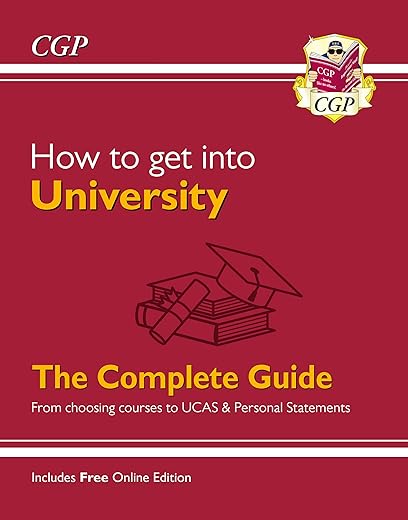
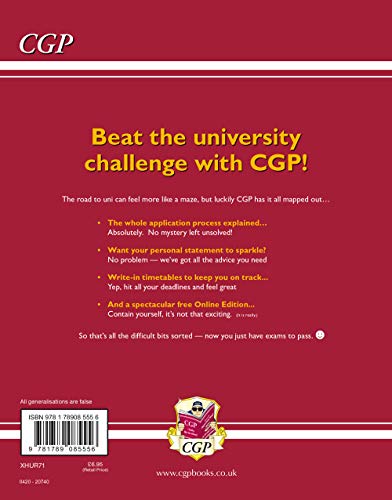
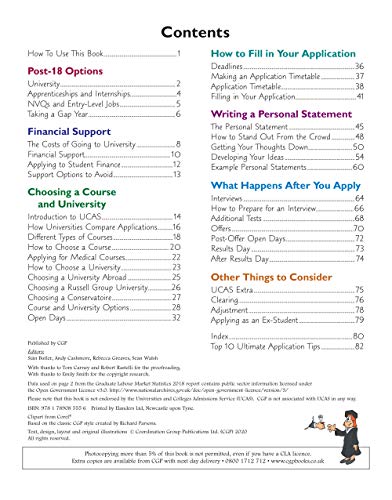
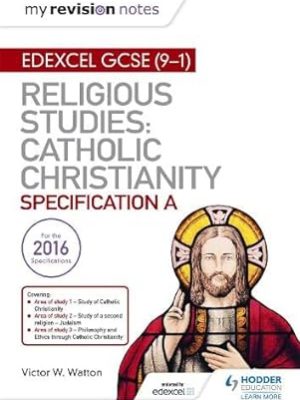

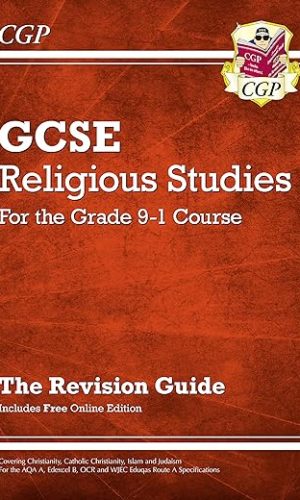
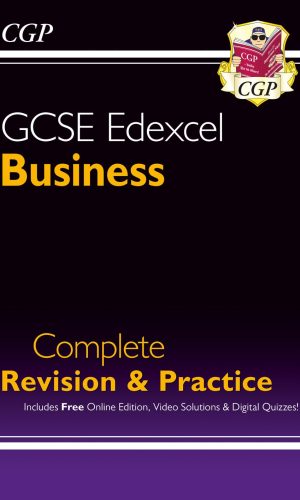
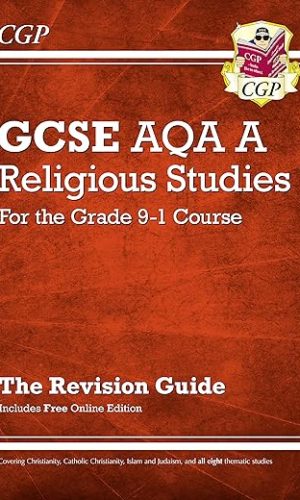
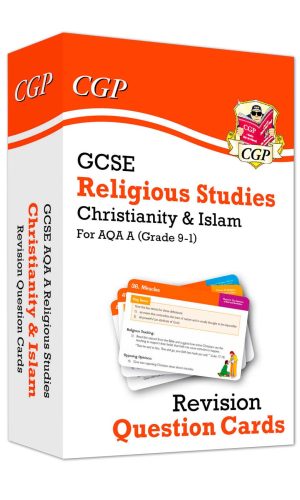
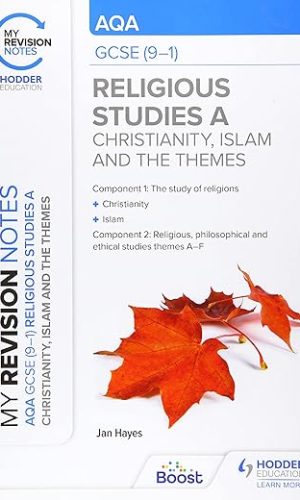
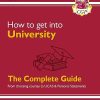
by Kate
Very informative
by Spawnee
Ok, but for a CGP publication this left me somewhat disappointed as it lacked the usual high level of detailed information – 3 Stars.
I’m a huge fan of the CGP range of study guides, but ‘How to get into University’ left me with mixed feelings. There were plenty of positive points, but I was expecting a little more:
The points I liked included:
Reality checks – These were present throughout and encouraged students to think carefully about their choices at each stage of the application process.
Timetable – One thing this guide does very well is explain the lengthy application process, and it offers good advice on making an application timetable.
Alternatives – Gap years, work-based qualifications, and distance learning are all discussed.
Finances – This highlights the need to consider all costs, and there’s information on the main types of funding available.
UCAS and Clearing – Clear and concise information on how they work.
What I didn’t like as much:
Presentation – The multi-coloured print and profusion of cartoons was very ‘busy’. Overall, I found the style of this guide a little immature for the topic being discussed.
Details – This is a very broad-based guide and offers little in the way of specifics. For example: If you want details of which university offers which courses, contact details for admissions offices, or specific information on ranking tables and student feedback, you’ll have to look elsewhere.
Mature students – I felt this was very much targeted at school leavers, and there was little to address the particular needs/questions mature students may have.
Overall: This certainly gives a good overview of the application process, but you’ll need other resources too.
by S Riaz
With my son just starting his A Levels, I thought this might be a useful guide to prepare him for applying for University (I went more years ago than I care to remember, so I am sure things have changed now).
This gives a good introduction to post-18 options, financial support, choosing a course and university, how to apply, how to write a personal statement, what happens next and other things to consider. This is a good overview and would be particularly useful for those unfamiliar with the process.
Hopefully, it will give my son some suggestions and make him aware that he needs to prepare as soon as possible and consider his options carefully before making any decisions.
by Spawnee
I have been a big fan of the CGP revision guides for GCSEs and A-Levels, but this “How to get into University: The Complete Guide” doesn’t quite hit the mark for me. I got this for my teenage son to look at, he is completing his GCSEs and is considering A-levels, and what he might do beyond FE college. I also work in higher education, so I was interested to see how this book supports potential university students to achieve their ambition of getting on the program of study they want.
Whilst it is good, I wouldn’t say it is quite the “complete guide” it makes itself out to be. It could be filled with much more detail, but instead, it is littered with “little jokes”, which I found annoying and distracting. I also found the font and layout not that helpful, and I think if you are someone who has an SpLD such as Dyslexia, this will be a challenge. I found it focussed too much on the UCAS route into applying to university and not enough on other routes that are sometimes required depending on the program of study you are thinking of choosing.
What is good about the book, is that it does cover the topic with a broad view. It does get the reader to consider the alternatives to studying at university which is something anyone who is planning on going to university should do, and I, therefore, do recommend that this could be a good read for any 16 years old in helping them to decide what to do for the next 5+ years (e.g what FE route they might want to take, or whether to go into an apprenticeship or find employments, etc.).
So whilst this is okay, and it is fairly unique as a topic for a book, and therefore choice might be limited, you may want to see what online tools are available for applying to university. Many universities have helpful hints and tips on their websites for example. Hopefully, a new edition will be published that is a bit more comprehensive, with better formatting, and less of the humour.
by The Reading Room
This phase may be, for some students, the first time in their life that they’ve been through this type of process, in terms of both the mechanics and the decision-making.
There is reasonable coverage of the decisions to make, e.g. do you want to go to university (giving examples of alternatives) and the criteria for choosing course and university (explaining that this can be chicken-and-egg). This includes guidance on applications to different types of institution, such as conservatoires.
The scope covers all stages from deciding on your applications to dealing with offers, and of course the dreaded clearing process. There is a whole chapter on personal statements. I was pleased to see there is also guidance on how to get the best out of open days and on the thorny issue of funding.
There is a code for access to the online edition, which many students will prefer.
Obviously applicants need to rely on the official sources, but this book is a useful overview.
The book should help my grand-daughter, though as she has recently submitted her applications part of it is now history for her.